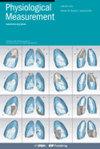Changes in physiological signal entropy in patients with obstructive sleep apnoea: a systematic review.
IF 2.3
4区 医学
Q3 BIOPHYSICS
引用次数: 0
Abstract
Background and Objective Obstructive sleep apnoea (OSA) affects an estimated 936 million people worldwide, yet only 15% receive a definitive diagnosis. Diagnosis of OSA poses challenges due to the dynamic nature of physiological signals such as oxygen saturation (SpO2) and heart rate variability (HRV). Linear analysis methods may not fully capture the irregularities present in these signals. The application of entropy of routine physiological signals offers a promising method to better measure variabilities in dynamic biological data. This review aims to explore entropy changes in physiological signals among individuals with OSA. Methods Keyword and title searches were performed on Medline, Embase, Scopus, and CINAHL databases. Studies had to analyse physiological signals in OSA using entropy. Quality assessment used the Newcastle-Ottawa Scale. Evidence was qualitatively synthesized, considering entropy signals, entropy type, and time-series length. Main results Twenty-two studies were included. Multiple physiological signals related to OSA, including SpO2, HRV, and the oxygen desaturation index (ODI), have been investigated using entropy. Results revealed a significant decrease in HRV entropy in those with OSA compared to control groups. Conversely, SpO2 and ODI entropy values were increased in OSA. Despite variations in entropy types, time scales, and data extraction devices, studies using receiver operating characteristic (ROC) curves demonstrated a high discriminative accuracy (>80% AUC) in distinguishing OSA patients from control groups. Conclusions This review highlights the potential of SpO2 entropy analysis in developing new diagnostic indices for patients with OSA. Further investigation is needed before applying this technique clinically. .阻塞性睡眠呼吸暂停患者生理信号熵的变化:系统综述。
背景和目的 据估计,全球有 9.36 亿人患有阻塞性睡眠呼吸暂停(OSA),但只有 15%的人得到明确诊断。由于血氧饱和度(SpO2)和心率变异性(HRV)等生理信号的动态性质,OSA 的诊断面临挑战。线性分析方法可能无法完全捕捉到这些信号中存在的不规则性。常规生理信号熵的应用为更好地测量动态生物数据中的变异性提供了一种很有前景的方法。本综述旨在探讨 OSA 患者生理信号的熵变化。方法 在 Medline、Embase、Scopus 和 CINAHL 数据库中进行关键词和标题检索。研究必须使用熵分析 OSA 的生理信号。采用纽卡斯尔-渥太华量表进行质量评估。考虑到熵信号、熵类型和时间序列长度,对证据进行了定性综合。使用熵对与 OSA 相关的多种生理信号进行了研究,包括 SpO2、心率变异和氧饱和度指数 (ODI)。结果显示,与对照组相比,OSA 患者的心率变异熵明显下降。相反,SpO2 和 ODI 的熵值在 OSA 患者中有所增加。尽管熵的类型、时间尺度和数据提取设备各不相同,但使用接收器操作特征曲线(ROC)进行的研究表明,在区分 OSA 患者和对照组时,熵的鉴别准确率很高(AUC >80%)。在将此技术应用于临床之前,还需要进一步的研究。
本文章由计算机程序翻译,如有差异,请以英文原文为准。
求助全文
约1分钟内获得全文
求助全文
来源期刊

Physiological measurement
生物-工程:生物医学
CiteScore
5.50
自引率
9.40%
发文量
124
审稿时长
3 months
期刊介绍:
Physiological Measurement publishes papers about the quantitative assessment and visualization of physiological function in clinical research and practice, with an emphasis on the development of new methods of measurement and their validation.
Papers are published on topics including:
applied physiology in illness and health
electrical bioimpedance, optical and acoustic measurement techniques
advanced methods of time series and other data analysis
biomedical and clinical engineering
in-patient and ambulatory monitoring
point-of-care technologies
novel clinical measurements of cardiovascular, neurological, and musculoskeletal systems.
measurements in molecular, cellular and organ physiology and electrophysiology
physiological modeling and simulation
novel biomedical sensors, instruments, devices and systems
measurement standards and guidelines.
 求助内容:
求助内容: 应助结果提醒方式:
应助结果提醒方式:


